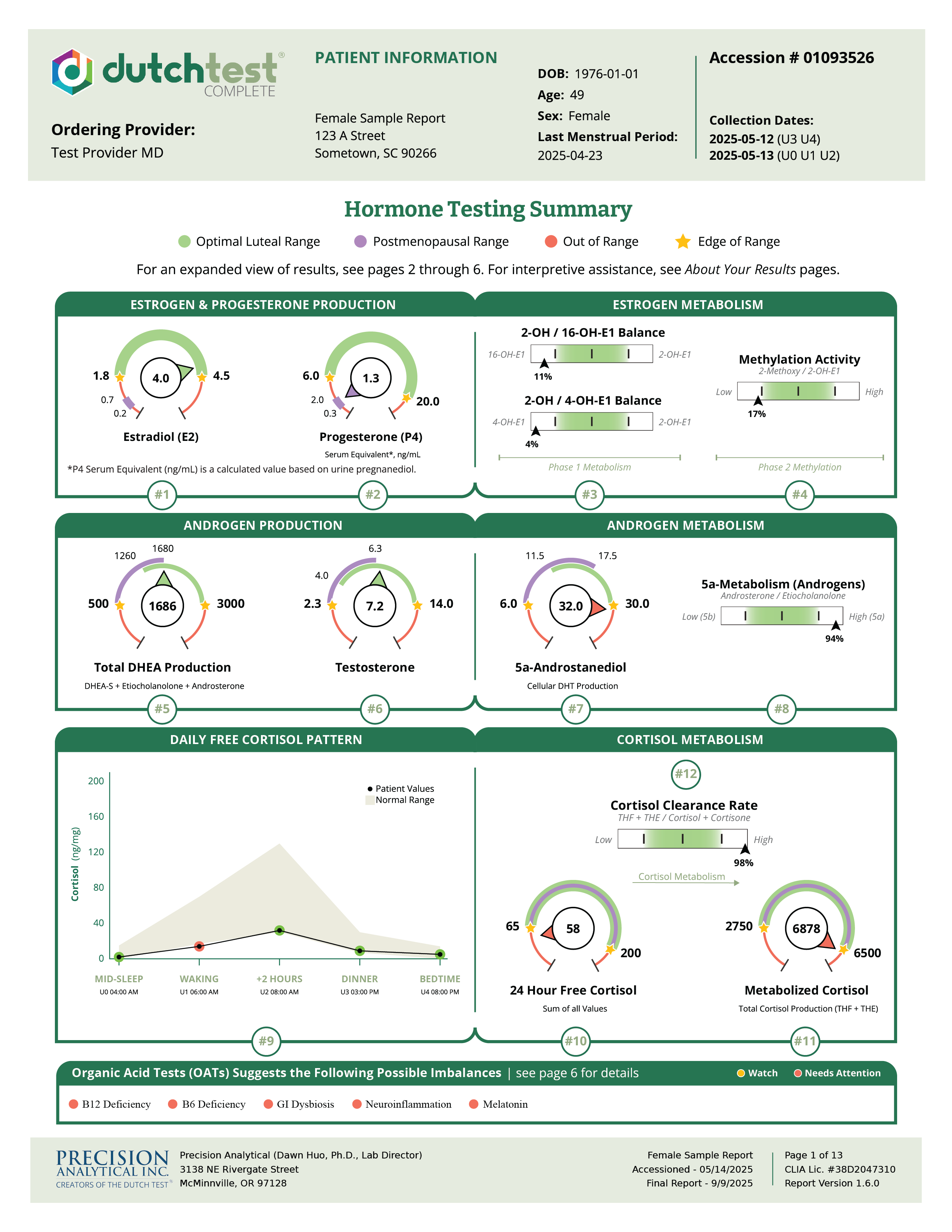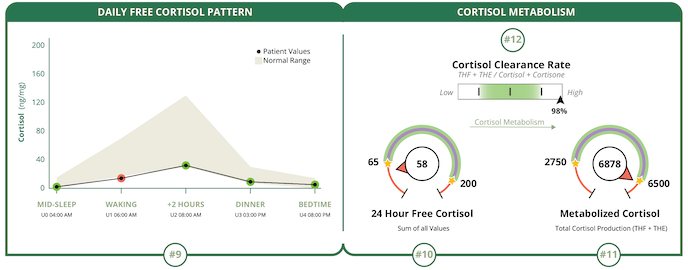The simplified DUTCH Report has arrived, and current DUTCH Providers are eligible for up to 5 DUTCH Complete or DUTCH Plus test kits for 50% off. Learn more and claim this offer!
Introducing the DUTCH Dozen
Kelly Ruef, ND
Hormone testing can be complex, which is why Precision Analytical developed the DUTCH Dozen, an interpretive framework that streamlines interpretation of the DUTCH Test, providing healthcare providers with a clear and actionable starting point for creating treatment plans.
The DUTCH Complete and DUTCH Plus tests now report your patient's specific results following this framework in the About Your Results sections, starting on page 7.
What is the DUTCH Dozen?
The DUTCH Dozen is an interpretive framework that allows clinicians to understand their patients’ DUTCH Test results quickly and comprehensively. We have streamlined the review of the DUTCH Test with a set of 12 assessments that prioritize the most critical aspects of hormone function-covering estrogens, progesterone, androgens, and cortisol. The DUTCH Dozen allows clinicians to quickly evaluate key hormone markers reported on the Hormone Testing Summary (page 1) of the report, making it easier and faster to get the necessary insights to develop targeted and successful treatment plans.
The female DUTCH Dozen is divided into three main categories: Estrogen and Progesterone (Assessments 1–4), Androgens (Assessments 5–8), and Cortisol (Assessments 9–12) (see Figure 1). The male DUTCH Dozen is similar; however, Androgens are evaluated first (Assessments 1-4), followed by Estrogen (Assessments 5-8), and then Cortisol (Assessments 9-12). Note that on the DUTCH Test report each section under “About Your Results” is individually numbered 1-4 (instead of 1-12): Estrogen and Progesterone (1-4), Androgens (1-4), Cortisol (1-4). Below we explore the DUTCH Dozen interpretive framework in more detail.

Figure 1: Page 1 of the report: The Female Hormone Testing Summary Page
Estrogen and Progesterone: Assessments 1–4 (5-8 on a male report)

Figure 2: Page 1 of the report: Estrogen and Progesterone section of the Female Hormone Testing Summary Page
1. Assess estrogen levels given the patient’s reproductive status
The first assessment evaluates estrogen levels based on the patient’s reproductive status. Estradiol (E2) is the most potent estrogen and drives significant estrogenic activity in the body compared to estrone (E1), estriol (E3), and their metabolites. Normal estrogen levels vary depending on factors like age, menstrual cycle phase, or menopausal status. This assessment ensures that estrogen levels align with what’s expected for the patient’s reproductive context, flagging potential excesses or deficiencies.
2. Assess progesterone levels given the patient’s reproductive status
Progesterone (P4) is critical for counteracting estrogen’s proliferative effects and supporting overall hormonal balance. The second assessment checks whether progesterone levels are adequate, particularly for cycling females in the luteal phase. The DUTCH Test’s Hormone Testing Summary (page 1) includes dials for Estradiol (E2) and Progesterone (P4) Serum Equivalent, allowing clinicians to compare these hormones and assess their relative balance. This is especially important for addressing symptoms related to estrogen dominance.
3. Assess 2-OH preference in phase 1 estrogen metabolism
Estrogen metabolism occurs in phases, and the third assessment focuses on phase 1, specifically the preference for the 2-OH pathway. The 2-OH estrogen metabolites are more stable and protective compared to the 16-OH and 4-OH metabolites. The 2-OH/16-OH-E1 Balance Slider shows the ratio of 2-OH-E1 to 16-OH-E1, where a shift toward 16-OH may potentially worsen estrogen excess associated symptoms and conditions. Similarly, the 2-OH/4-OH-E1 Balance Slider compares 2-OH-E1 to 4-OH-E1, an oxidative metabolite linked to DNA damage and increased breast cancer risk. A low 2-OH/4-OH ratio (below 20%–30%) may signal a need for intervention to optimize estrogen metabolism.
4. Assess methylation of 2-OH estrogens
The fourth assessment evaluates phase 2 estrogen detoxification, focusing on the methylation of 2-OH estrogens. The Methylation Activity Slider shows the ratio of 2-Methoxy-E1 (a stable, neutral metabolite) to 2-OH-E1. Lower methylation activity (below 20%–30%) may indicate suboptimal detoxification. In some cases, methylation activity above 30% may be more beneficial to support safe estrogen clearance: for example, if 2-OH, 4-OH, E1, and E2 levels are elevated.
By looking at estrogen and progesterone levels, their balance, and estrogen metabolism pathways together, you can clearly understand how hormone production and detoxification may be contributing to your patient’s symptoms and health risks.
Androgens: Assessments 5–8 (1-4 on a male report)

Figure 3: Page 1 of the report: Androgen section of the Female Hormone Testing Summary Page
5. Assess adrenal androgen levels (Total DHEA Production)
The fifth assessment measures Total DHEA Production, a key adrenal androgen. Total DHEA Production is calculated as the sum of three urinary metabolites: DHEA-S, etiocholanolone, and androsterone. This metric reflects the adrenal glands’ overall androgen production, which is essential for energy, libido, and muscle health. Abnormal DHEA levels may indicate adrenal dysfunction, warranting further investigation.
6. Assess testosterone levels
Testosterone is evaluated in the sixth assessment, focusing on bioavailable conjugated testosterone in urine, which typically correlates with serum free testosterone. This assessment helps identify issues like low libido, fatigue, or muscle weakness, particularly in men or women with androgen deficiency. Note that low urinary testosterone should be confirmed with serum testing before considering treatment.
7. Assess cellular production of 5a-DHT via 5a-androstanediol
The seventh assessment examines the production of 5a-dihydrotestosterone (5a-DHT) via looking at 5a-androstanediol. 5a-DHT is the most potent androgen with four times the androgenic activity of testosterone. 5a-androstanediol is a metabolite that reflects intracellular 5a-DHT production and activity. This is critical for understanding conditions like hirsutism, acne, or androgen-driven hair loss.
8. Assess if there is a preference for the more potent alpha metabolism of the androgens
The eighth assessment evaluates the preference for 5a-reductase metabolism, which produces more potent androgens. The 5a-Metabolism (Androgens) Slider compares androsterone (5a) to etiocholanolone (5b). A shift toward 5a metabolites indicates higher androgenic activity, which may contribute to symptoms like oily skin, acne, or hair loss. However, an alpha preference may not require intervention if androgen excess symptoms are absent.
By looking at DHEA, testosterone, and 5a-androstanediol levels and androgen metabolism pathways together, you can clearly understand how androgen levels and androgen metabolism preferences (alpha vs. beta) are affecting androgen activity and influencing your patient’s symptoms.
Cortisol (Assessments 9–12)

Figure 4: Page 1 of the report: Cortisol section of the Female Hormone Testing Summary Page
9. Assess the daily free cortisol pattern
The ninth assessment analyzes the daily free cortisol pattern, plotted from urine samples collected throughout the day. The waking urine sample reflects overnight cortisol, while the morning urine sample represents the peak. This pattern helps identify disruptions in the diurnal cortisol rhythm, which can affect energy, sleep, and stress response.
10. Assess the daily total of free cortisol in circulation (24hr Free Cortisol)
The tenth assessment measures the total daily free cortisol in circulation, calculated as the sum of four points on the Daily Free Cortisol Pattern. This dial provides insight into overall cortisol levels in circulation on the day of testing, which is crucial for assessing conditions like burnout or hypercortisolism.
11. Assess the total cortisol produced by the adrenal glands (Metabolized Cortisol)
The eleventh assessment evaluates total adrenal cortisol production by summing the cortisol metabolites a-THF, b-THF, and b-THE. This metric, known as Metabolized Cortisol, reflects the adrenal glands’ cortisol output, offering a broader perspective on adrenal function.
12. Assess the rate of cortisol clearance from the body
The final assessment examines the cortisol clearance rate (CCR), calculated as the ratio of THF + THE to cortisol + cortisone. A low CCR (below 20%) suggests slower clearance, while a high CCR (above 80%) indicates faster clearance. Both extremes may point to metabolic issues affecting the hypothalamic-pituitary-adrenal (HPA) axis, requiring further evaluation.
By looking at the daily free cortisol pattern, total cortisol in circulation (24hr Free Cortisol), total production of cortisol (Metabolized Cortisol), and rate of cortisol clearance from the body (CCR) together, you can clearly understand how cortisol levels in circulation may be impacting your patient’s symptoms and overall health, but also how metabolic processes (slow/hypometabolic vs fast/hypermetabolic CCR) may be influencing the patient’s HPA-axis.
Why the DUTCH Dozen Matters
The DUTCH Dozen offers a structured, efficient way to interpret complex hormone data, making it an invaluable interpretive framework for clinicians and patients. By focusing on these 12 assessments, practitioners can quickly identify hormone imbalances and prioritize interventions. For deeper insights and more detailed breakdown of the metabolic pathways, the additional pages of the report offer additional, valuable details. These additional report features will be easier to tie in with the overall hormone story when they complement a proper understanding of the DUTCH Dozen and the Summary Page.
Whether addressing estrogen excess, low testosterone, or cortisol dysregulation, the DUTCH Dozen empowers healthcare providers to make informed decisions. Patients benefit from a clearer understanding of their hormone health, paving the way for personalized treatment plans. As hormone testing continues to evolve, the DUTCH Dozen stands out as a practical and comprehensive framework for optimizing health and well-being.
TAGS
DUTCH Test: Basic Interpretation Resources